and John E. Skandalakis1
(1)
Centers for Surgical Anatomy and Technique, Emory University School of Medicine Piedmont Hospital, Atlanta, GA, USA
Abstract
The adrenal gland is hypervascular and friable. The adrenal glands vie with the thyroid gland for having the greatest blood supply per gram of tissue. The arterial supply is very rich. Unlike the left adrenal gland, the right adrenal gland rarely extends downward to the renal pedicle. The spleen, splenic capsule, splenic vessels, and the tail of the pancreas are enveloped by the splenorenal ligament. Both the kidney and the gland are covered with renal fascia.
In primary aldosteronism, meticulous attention to hemostasis is essential. Hematomas from operative trauma may disguise or mimic adenoma. Step-by-step technique is provided for exposure and mobilization of the adrenal gland and the many adrenalectomy procedures. With laparoscopic adrenalectomy, the transabdominal lateral approach provides the best overall view of the areas of dissection and surrounding structures.
Anatomy
General Description of the Adrenal Glands
Each adrenal gland, together with the associated kidney, is enclosed in the renal fascia (of Gerota) and surrounded by fat.
The glands are firmly attached to the fascia, which is in turn attached firmly to the abdominal wall and the diaphragm. A layer of loose connective tissue separates the capsule of the adrenal gland from that of the kidney. Because the kidney and the adrenal gland are thus separated, the kidney can be ectopic or ptotic without a corresponding displacement of the gland. Fusion of the kidneys, however, is often accompanied by fusion of the adrenal glands.
Occasionally the adrenal gland is fused with the kidney so that separation is almost impossible. If individuals with such a fusion need a partial or total nephrectomy, they also require a coincidental adrenalectomy.
The medial borders of the right and left adrenal glands are about 4.5 cm apart. In this space, from right to left, are the inferior vena cava, the right crus of the diaphragm, part of the celiac ganglion, the celiac trunk, the superior mesenteric artery, the other part of the celiac ganglion, and the left crus of the diaphragm.
Relations of the Adrenal Glands
Each adrenal gland has only an anterior and a posterior surface. Some of the relationships to other structures can be seen in Fig. 16.1.
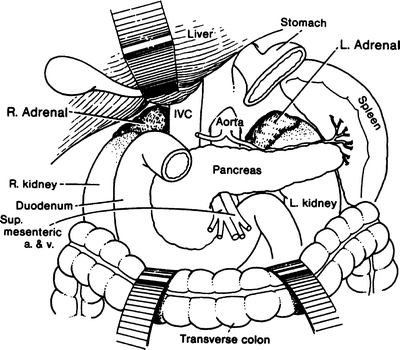

Figure 16.1.
The relations of the adrenal glands from the anterior approach (By permission of JE Skandalakis, SW Gray, and JR Rowe. Anatomical Complications in General Surgery. New York: McGraw-Hill, 1983).
Right Adrenal Gland
Anterior surface
a.
Superior: “bare area” of liver
b.
Medial: inferior vena cava
c.
Lateral: “bare area” of right lobe of the liver
d.
Inferior: peritoneum (very rarely, if ever) and first part of the duodenum (occasionally)
Posterior surface
a.
Superior: diaphragm
b.
Inferior: anteromedial aspect of right kidney
Left Adrenal Gland
Anterior surface
a.
Superior: peritoneum (posterior wall of omental bursa) and stomach
b.
Inferior: body of the pancreas
Posterior surface
a.
Medial: left crus of diaphragm
b.
Lateral: medial aspect of the left kidney
Vascular System of the Adrenal Glands
Arterial Supply
The arterial supply of the adrenal glands arises, in most cases, from three sources: (Fig. 16.2)
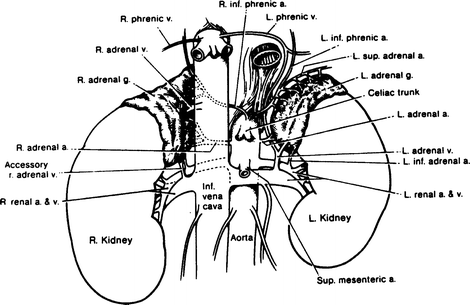

Figure 16.2.
The arterial supply and venous drainage of the adrenal glands. As many as 60 arterial twigs may enter the adrenal gland. One or, occasionally, two veins drain the adrenal gland (By permission of JE Skandalakis, SW Gray, and JR Rowe. Anatomical Complications in General Surgery. New York: McGraw-Hill, 1983).
The superior adrenal arteries. A group of six to eight arteries arises separately from the inferior phrenic arteries.
The middle adrenal artery arises from the aorta just proximal to the origin of the renal artery. It can be single, multiple, or absent. It supplies the perirenal fat only.
One or more inferior adrenal arteries arise from the renal artery, an accessory renal artery, or a superior polar artery. Small twigs may arise from the upper ureteric artery.
All these arteries branch freely before entering the adrenal gland, so 50–60 arteries penetrate the capsule over the entire surface.
Venous Drainage
The adrenal venous drainage does not accompany the arterial supply and is much simpler (Fig. 16.2). A single vein drains the adrenal gland, emerging at the hilum. The left adrenal vein passes downward over the anterior surface of the left adrenal gland. This vein is joined by the left inferior phrenic vein before entering the left renal vein. From the right adrenal gland, the right adrenal vein passes obliquely to open into the inferior vena cava posteriorly.
Occasionally an adrenal gland has two veins, one following a normal course and the other being an accessory vein that enters the inferior phrenic vein.
When the posterior approach to the adrenal gland is used, the left adrenal vein is found on the anterior surface of the gland. The right adrenal vein is found between the inferior vena cava and the gland. Careful mobilization of the gland is necessary for good ligation of the vein.
Remember:
✓ The adrenal glands vie with the thyroid gland for having the greatest blood supply per gram of tissue.
Lymphatic Drainage
The lymphatics of the adrenal gland are usually said to consist of a profuse subcapsular plexus that drains with the arteries and a medullary plexus that drains with the adrenal veins. Drainage is to renal hilar nodes, lateral aortic nodes, and nodes of the posterior mediastinum above the diaphragm by way of the diaphragmatic orifices for the splanchnic nerves (Fig. 16.3). Lymphatics from the upper pole of the right adrenal gland may enter the liver. The majority of capsular lymphatic vessels pass directly to the thoracic duct without the intervention of lymph nodes.


Figure 16.3.
The lymphatics of the adrenal glands (By permission of JE Skandalakis, SW Gray, and JR Rowe. Anatomical Complications in General Surgery. New York: McGraw-Hill, 1983).
Technique
Adrenalectomies
Anterior Approach
The anterior approach is preferred when (1) the adrenal disease is bilateral (10 %), (2) the tumor is over 10 cm in size, or (3) the tumor has invaded surrounding structures. Using the anterior approach, both glands can be inspected, palpated, or biopsied. (In spite of this advantage, the use of the posterior approach has increased because of improvements in preoperative diagnosis, such as CT and selective adrenal angiography.)
The incision for an anterior approach may be vertical, midline or paramedian, transverse, or chevron (Fig. 16.4).
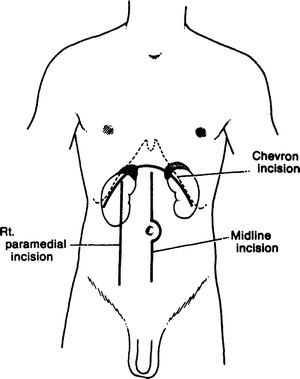

Figure 16.4.
Incisions for anterior exposure of the adrenal glands. The chevron transabdominal incision provides bilateral exposure (By permission of JE Skandalakis, SW Gray, and JR Rowe. Anatomical Complications in General Surgery. New York: McGraw-Hill, 1983).
Exposure and Mobilization of the Left Adrenal Gland
Exposure of the left adrenal gland begins with the incision of the posterior parietal peritoneum lateral to the left colon. The incision is carried upward, dividing the splenorenal ligament (Fig. 16.5). Avoid injury to the spleen, splenic capsule, splenic vessels, and the tail of the pancreas, which are enveloped by the splenorenal ligament.
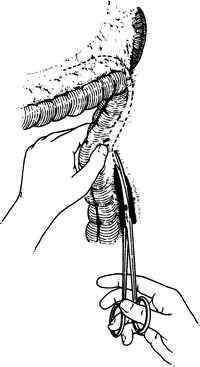

Figure 16.5.
Incision of the parietal peritoneum lateral to the left colon. The incision divides the splenorenal ligament (By permission of JE Skandalakis, SW Gray, and JR Rowe. Anatomical Complications in General Surgery. New York: McGraw-Hill, 1983).
Another approach to the left adrenal is to open the lesser sac through the gastrocolic omentum. The incision should be longitudinal outside the gastroepiploic arcade (Fig. 16.6). Care must be taken to avoid traction on the spleen or the splenocolic ligament. The ligament may contain tortuous or aberrant inferior polar renal vessels or a left gastroepiploic artery.


Figure 16.6.
Approach to the left adrenal through the gastrocolic omentum opening the lesser sac (By permission of JE Skandalakis, SW Gray, and JR Rowe. Anatomical Complications in General Surgery. New York: McGraw-Hill, 1983).
In both approaches, the peritoneum under the lower border of the pancreas should be incised halfway along the tail and the incision extended laterally for about 10 cm. By gently retracting the pancreas upward, the left adrenal gland on the superior pole of the left kidney will be exposed. Both the kidney and the gland are covered with renal fascia (of Gerota). The gland will lie lateral to the aorta, about 2 cm cranial to the left renal vein. By incising the renal fascia, the adrenal gland is completely exposed and the adrenal vein is accessible.
If the operation is for pheochromocytoma, the adrenal vein should be ligated at once to prevent the release of catecholamines into the circulation during subsequent manipulation of the gland. If it is impossible to refrain from using retractors in this area, place them gently to avoid tearing the inferior mesenteric vein from the splenic vein.
In patients whose left adrenal lesion is anterior, a third approach is useful. The gland is exposed by an oblique incision of the left mesocolon (Fig. 16.7). The arcuate vessels may be divided, but the major branches of the middle and left colic arteries must be preserved. Injury to the wall of the left colon can be avoided by minimizing retraction.
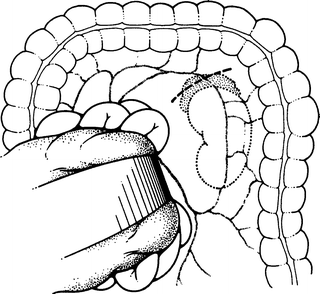

Figure 16.7.
Approach to the left adrenal by incision of the left mesocolon near the splenic flexure. The major branches of the middle and left colic arteries must be spared, but the marginal artery may be sectioned (By permission of JE Skandalakis, SW Gray, and JR Rowe. Anatomical Complications in General Surgery. New York: McGraw-Hill, 1983).
In primary aldosteronism, meticulous attention to hemostasis is essential because the adrenal gland is hypervascular and friable. Hematomas from operative trauma may disguise or mimic adenoma. Use part of the adjacent periadrenal fascia to handle the gland. For manipulation, use only fine forceps. The numerous arteries can be clipped or electrocoagulated to maintain hemostasis.
The dissection starts at the inferolateral aspect of the left adrenal gland and proceeds superiorly (Fig. 16.8). Remaining alert to the possible presence of a superior renal polar artery, the surgeon should retract the gland superiorly. Remember that the left adrenal gland extends downward, close to the left renal artery and vein.
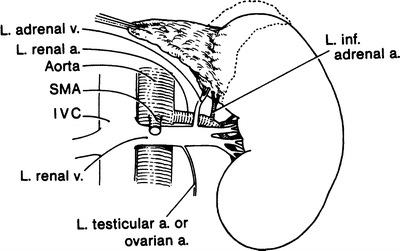

Figure 16.8.




Direction of dissection of the left adrenal gland. Note the position of the left adrenal vein (By permission of JE Skandalakis, SW Gray, and JR Rowe. Anatomical Complications in General Surgery. New York: McGraw-Hill, 1983).
Stay updated, free articles. Join our Telegram channel

Full access? Get Clinical Tree


